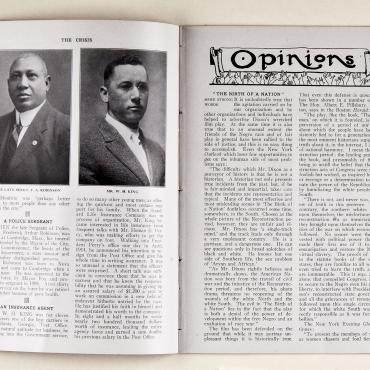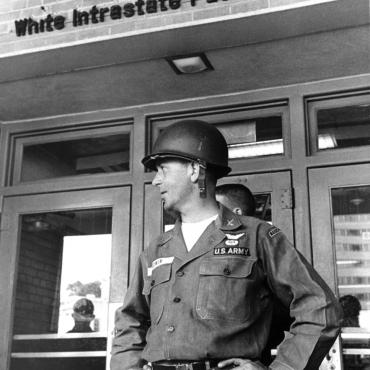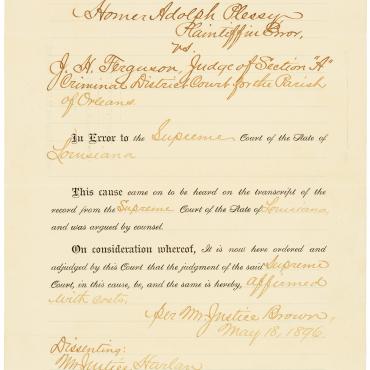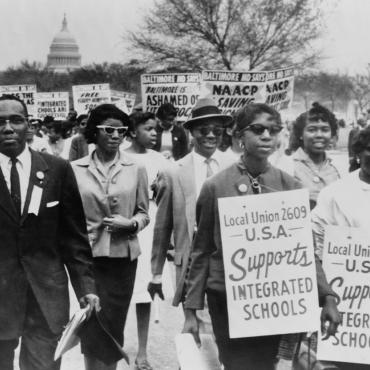
Compare Coverage of Brown v. Board Ruling
In this lesson, students analyze how three newspapers covered the 1954 landmark Supreme Court decision that struck down the legality of segregation in U.S. public schools. The ruling was a major turning point in the civil rights movement.
Get even more great free content!
This content contains copyrighted material that requires a free NewseumED account.
Registration is fast, easy, and comes with 100% free access to our vast collection of videos, artifacts, interactive content, and more.
NewseumED is provided as a free educational resource and contains copyrighted material. Registration is required for full access. Signing up is simple and free.
With a free NewseumED account, you can:
- Watch timely and informative videos
- Access expertly crafted lesson plans
- Download an array of classroom resources
- and much more!
- Civil Rights
- Journalism
- Supreme Court
- 7-12
On May 18, 1896, the Supreme Court ruled in the case of Plessy v. Ferguson that “separate” accommodations for whites and blacks were constitutional as long as they were “equal.” The Plessy doctrine led to legalized racial segregation across the United States in all aspects of public life, including public schools, restrooms and restaurants.
The ruling would stand until almost exactly 58 years later, when the Supreme Court ruled in Brown v. Board of Education of Topeka that separate facilities were often inferior for blacks and therefore segregation laws were unconstitutional. In reading the majority opinion in a case challenging segregation in schools, Chief Justice John Warren declared, “Separate educational facilities are inherently unequal.” The ruling was intended to reverse decades of unequal treatment that African Americans faced in the United States.
Most newspapers around the United States reported on this landmark case, showcasing the mixed reactions. While some states celebrated the ban on segregation, others defended their segregation laws and pushed back against the ruling, noting that the court did not set a timeline for integration in its decision. So, amid the resistance, the Supreme Court addressed implementation in Brown v. Board II a year later.
- Front pages of The Topeka State Journal, Jackson Daily News and The Providence Journal. (See instructions.)
- Comparing Brown v Board handout (download)
- Graphic Organizer worksheet (download, optional)
- Internet access (optional)
- You may want to read to your students the brief background on the case, found above and in the lesson plan.
- Have students analyze coverage of the court ruling in three newspapers – The Topeka State Journal, Jackson Daily News and The Providence Journal. You may download and print out the front pages, provide links to the digital copies, or have students view them in the gallery below.
- Have students – individually or in small groups – answer the discussion questions, found below and in the handout. You may also choose to have them first take notes using the Graphic Organizer.
- When students are finished, discuss their findings as a group.
- The three front pages contain a variety of reactions from across the country but what commonalities do they share? How do they differ? What do those shared aspects indicate of the state of racial relations across the United States at the time?
- Are there any underlying messages or themes that the papers are trying to convey through their front pages? Consider the titles, photographs, accompanying articles and the geographic location of the papers in your analysis.
- Do you think the ruling against a local school district influenced The Topeka Journal coverage? How?
- According to The Topeka State Journal, which states had laws that required segregation? Were they concentrated in one part of the country or spread out? Are you surprised by this or is this what you expected? Are any of these papers from states that had school segregation?
- What amendment was responsible for granting citizenship to newly freed slaves? How did that relate to segregation? Why was it brought up in The Topeka State Journal article?
- Why do you think the Supreme Court justices didn’t include a plan for implementing desegregation?
- Watch this Newseum-produced video of journalist Hodding Carter III explaining how Brown v. Board made the press pay attention to the African-American community. The news media up until this point had minimized the black community. Furthermore, Carter explains that the Supreme Court decision was a reflection of American public opinion rejecting segregation. Ask students: What do you think the role of the press should be in advancing civil rights? Does the press do a sufficient job of this today? Why or why not?
- Ask students for their initial answers to the following questions, then have them do research to refine their answers. Does everyone in America have a chance for equal education? Are there still traces of segregation in today’s public schools? How do you think the history of segregation affects education today?
-
Common Core State Standards: CCSS.ELA-LITERACY.CCRA.R.3
Analyze how and why individuals, events, or ideas develop and interact over the course of a text. -
Common Core State Standards: CCSS.ELA-LITERACY.CCRA.R.9
Analyze how two or more texts address similar themes or topics in order to build knowledge or to compare the approaches the authors take.
-
NCSS C3 Framework: D2.His.12.6-8 and D2.His.12.9-12
6 - 8: Use questions generated about multiple historical sources to identify further areas of inquiry and additional sources. 9 - 12: Use questions generated about multiple historical sources to pursue further inquiry and investigate additional sources. -
NCSS C3 Framework: D2.His.14.6-8 and D2.His.14.9-12
6 - 8: Explain multiple causes and effects of events and developments in the past. 9 - 12: Analyze multiple and complex causes and effects of events in the past. -
NCSS C3 Framework: D2.His.5.6-8 and D2.His.5.9-12
6 - 8. Explain how and why perspectives of people have changed over time. 9 - 12. Analyze how historical contexts shaped and continue to shape people’s perspectives. -
NCSS C3 Framework: D3.1.6-8 and D3.1.9-12
6 - 8: Gather relevant information from multiple sources while using the origin, authority, structure, context, and corroborative value of the sources to guide the selection. 9 - 12: Gather relevant information from multiple sources representing a wide range of views while using the origin, authority, structure, context, and corroborative value of the sources to guide the selection
-
National Center for History in the Schools: NCHS.Historical Thinking.2
A. Identify the author or source of the historical document or narrative and assess its credibility. B. Reconstruct the literal meaning of a historical passage. C. Identify the central question(s) the historical narrative addresses. D. Differentiate between historical facts and historical interpretations. E. Read historical narratives imaginatively. F. Appreciate historical perspectives. G. Draw upon data in historical maps. H. Utilize visual, mathematical, and quatitative data. -
National Center for History in the Schools: NCHS.US History.Era 9
Standard 1: The economic boom and social transformation of postwar United States Standard 2: How the Cold War and conflicts in Korea and Vietnam influenced domestic and international politics Standard 3: Domestic policies after World War II Standard 4: The struggle for racial and gender equality and for the extension of civil liberties
-
National Council of Teachers of English: NCTE.11
Students participate as knowledgeable, reflective, creative, and critical members of a variety of literacy communities.
-
NCSS Curriculum Standards: NCSS 2
Learners examine the institutions, values and beliefs of people in the past, acquire skills in historical inquiry and interpretation, and gain an understanding of how important historical events and developments have shaped the modern world. -
NCSS Curriculum Standards: NCSS 3
Learners examine where people, places and resources are located, why they are there and why it matters. -
NCSS Curriculum Standards: NCSS 5
Students know how institutions are formed, maintained and changed, and understand how they influence individuals, groups and other institutions. -
NCSS Curriculum Standards: NCSS 6
Learners will develop an understanding of the principles, processes, structures and institutions of government, and examine how power and authority are or have been obtained in various systems of government. -
NCSS Curriculum Standards: NCSS 10
Learning how to apply civic ideals to inform civic action is essential to participation in a democracy and support for the common good.


























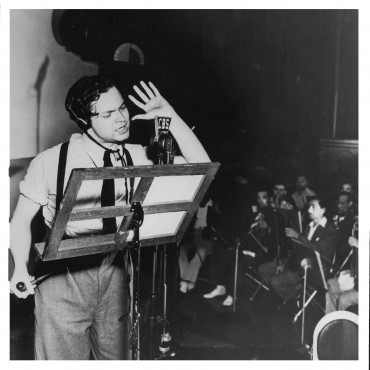

































_663bf.jpg)




